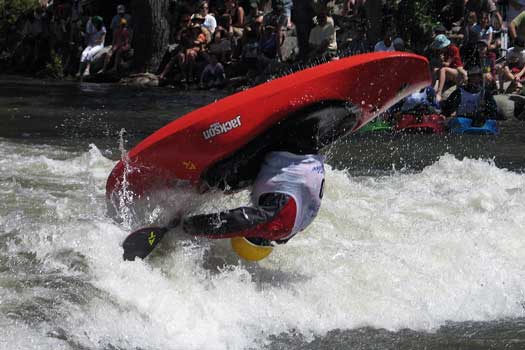Manoeuvre Terminology
Kayaking terminology used to name various turns and rolls
Paddle Strokes
- Box (ready) position
- Holding your paddle with your arms and wrists at 90 degree angles.
- Forward stroke
- The most intuitive stroke that can take a while to fully master. Reaching forward you should try and use your torso to rotate the paddle blade back to your hips and rather than using your leading arm to pull, pushing with your trailing arm.
- Backstroke
- Reverse of the forward stroke.
- Low brace
- Slapping the blade down on the water and pushing down to prevent one from flipping over.
- High brace
- Forward sweep
- Move the blade from the bow horizontally near the surface to the stern in a semicircle.
- Back (reverse) sweep
- Move the blade from the stern horizontally near the surface to the bow in a semicircle.
- Kayak roll
- Uprighting yourself after a capsize.
- Boofing
- Rising your bow when doing a freefall so that you land flat. Aerated water has a cushioning effect, but boofing high drops off waterfalls could result with a broken back.
- Pencil
- A drop where you land vertically with the bow pointing downwards.
Rescues and Safety
- Personal flotation devices (PFD)
- Also known as life jackets.
- Throw ropes
- A coiled rope in a bag that can be thrown to a paddler in distress. One end is anchored before the bag is thrown.
- Spotters
- Having someone nearby to provide support if the paddler gets into trouble. For example, someone on the shore beside the rapid with a throw rope.
- Scouting
- Looking at a rapid or obstacle before attempting to paddle it. Especially important when you can not see the entire rapid even if you are familiar with it, as the flow may have altered the run or logs may be present.
- Swimming
-
Leaving the kayak and entering the water.
If caught in a hole you should try hitch a ride with the current down and under the wave. Trying to fight through the aerated water can be difficult and you could be caught in the circulating water at the surface. Curling up into a ball (shallow exit) or swimming downwards (deeper water) should assist doing this. Recommended advice with strainers that can not be avoided is to aggressively swim directly towards the obstruction and try to lunge up on top of the structure. Being passive will cause you to lose momentum and be more likely carried underwater.
- Defensive Swimming (body surfing)
- Floating downstream with your feet raised and arms out to your sides. This helps to minimise feet entrapment and also to prevent head injuries.
- Offensive Swimming
- A very aggressive forward stroke, usually with your head above water.


